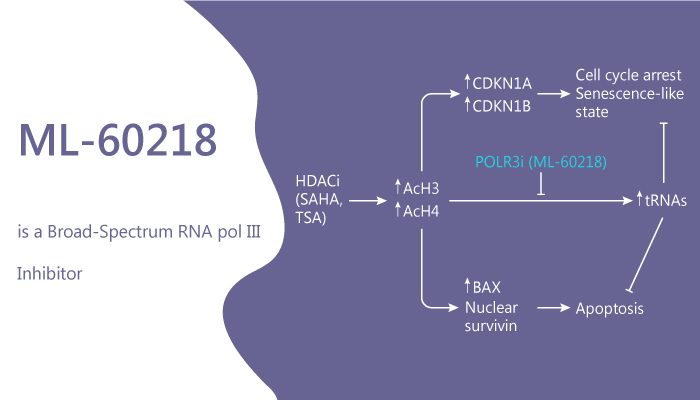Histone deacetylases (HDACs) and RNA polymerase III (POLR3) play vital roles in fundamental cellular processes. In particular, POLR3 mediates transcription of non-coding RNAs. ML-60218 is a potent and selective inhibitor of POLR3-mediated transcription in eukaryotes. ML-60218 inhibits yeast Saccharomyces cerevisiae and human RNA Pol III with IC50 values of 32 and 27 μM, respectively. Therefore, ML-60218 represents a novel inhibitor with activity against RNA Pol III enzymes from yeast to humans.

ML-60218 is a small molecule inhibitor with high pol III specificity. In zebrafish larvae, combination of Trichostatin A and ML-60218 synergistically prohibits the expansion of exocrine pancreas. In human pancreatic adenocarcinoma cells, combination of the HDAC inhibitor SAHA and ML-60218 produces augmented suppression of colony formation and proliferation, and induction of cell cycle arrest and apoptotic cell death.
The tRNAs has pro-proliferative and anti-apoptotic roles, and ML-60218 reverses SAHA-stimulated expression of tRNAs. Combination of SAHA and ML-60218 also produces enhanced suppression of proliferation in human pancreatic adenocarcinoma by impairing cell cycle progression and inducing apoptosis. Furthermore, SAHA and ML-60218 inhibit anchorage-independent colony formation and induce cellular morphology consistent with cellular senescence and cell death. Moreover, SAHA and ML-60218 cooperatively up-regulate expression of BAX and p21CDKN1A protein. Especially, ML-60218 decreases pre-tRNATyr by ∼59% and stimulates expression of Synaptophysin and Neuron specific enolase mRNAs at a concentration (20 μM).
To summarise, HDAC inhibitors and the POLR3 inhibitor ML-60218 produces supra-additive suppression of epithelial proliferation with cell cycle arrest in the developing exocrine pancreas of zebrafish as well as in the Gemcitabine-resistant human pancreatic adenocarcinoma cell lines.